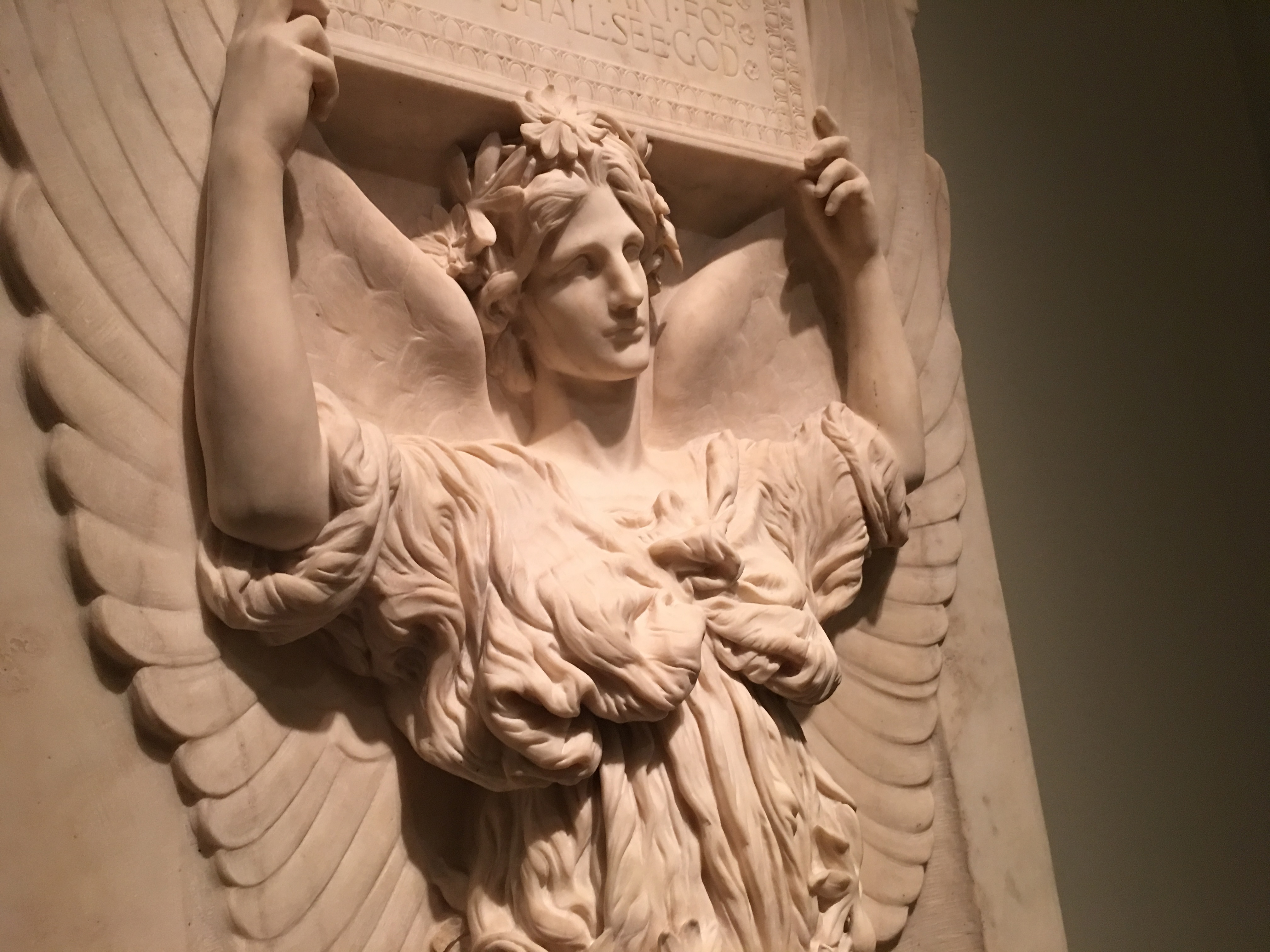The Angel of Purity
This December, I’ve had angels on the brain. According to the Bible, on the night Jesus was born, it was an angel who announced the good news to the shepherds tending their flocks in the fields of Bethlehem. Suddenly a great company of the heavenly host appeared with the angel and joined in praise to God,[1] which sourced the Christmas hymns still sung today.
Angels are best known as God’s musicians for their sweet choral singing and harp-playing, but they are also celebrated as God’s messengers for delivering news from the spiritual realm down to the human plane of existence. Most of the time, angels deliver happy news, but sometimes they deliver sad news. I’ve seen a lot of art in my days, but the piece that never fails to bring me to tears is an angel who currently lives in the Philadelphia Museum of Art (“PMA”), delivering the most melancholy message mankind could ever try to comprehend.
The Angel of Purity was sculpted in 1902 by Augustus Saint-Gaudens, a working class Irish immigrant who rose from the depths of The Bowery in New York City to become the preeminent sculptor of the American Renaissance.[2] Doubtlessly the Saint-Gaudens sculpture most recognizable to PMA visitors due to its flashiness and prominent placement is Diana, the ancient Greek goddess of the hunt. Diana was the weather vane on top of Madison Square Garden from 1893 to 1925, when the New York Life Insurance Company gifted her to the PMA, where she dominates the balcony of the Great Stair Hall. Standing with one foot on her golden ball, in shimmering nudity[3] with her bow and arrow tautly poised, she looks like she could suddenly make a quarter-turn and shoot people down on the stairway like rabbits.
The Angel of Purity is Diana’s total opposite. Lesser known due to her out-of-the-way placement and pale shade of marble that blends into the wall, she can be found hanging at the very end of the hallway in the Korman Gallery (#120), which you can access by climbing The Rocky Steps, entering the building via the East Entrance doors, and making an immediate left.
Dr. S. Weir Mitchell, a prominent Philadelphia physician, and his wife, Mary Cadwalader Mitchell, commissioned The Angel of Purity as a memorial to their daughter, Maria, who died of diphtheria when she was only 22. We don’t know much about Maria except for that she used to teach children’s classes at Saint Stephen’s Episcopal Church on South 10th Street, which was the sculpture’s original home until the congregation (facing a shrinking endowment) had to sell it. Thanks to the PMA’s former director, Anne D’Harnoncourt, who encouraged hundreds of donors to pledge their support, the PMA was able to acquire The Angel of Purity in 2005 and put it on view for the people of Philadelphia and visitors from all over the globe to admire.
The facial features of The Angel of Purity were modeled after the same woman Diana was modeled after (Saint-Gaudens’ mistress Davida Clark) and she wears a Grecian robe hearkening back to classical antiquity, but that’s where the resemblance between the two statues ends. The Angel of Purity is modest, humble, and pacifistic,[4] characteristic of angels not goddesses. She wears a crown and belt of passion-flowers, a North American plant symbolic of Christ’s passion, and holds a tablet above her head bearing the inscription: “Blessed are the Pure in Heart For They Shall See God.”
Maybe it’s the well-placed spotlight illuminating her from above like heaven’s rays, or the radiant ivory of the marble she’s carved from or some magical combination of both, but The Angel of Purity seems to glow from within as if the warmth of Maria’s soul were re-animating the cold stone. When I look up at her, I have the urge to reach out and touch her bare toe peeking out from under her flowing garment.[5] My mixed emotions are hard to describe. Let’s see. First, there’s gratefulness - that such a thing of beauty lives among us mere mortals. Next, there’s awestruck amazement – that the Mitchells (through their devotion) and Saint-Gaudens (through his artistry) achieved the ambitious goal of immortalizing Maria; and finally, there’s sorrowful grief with the overwhelming power of an avalanche. Not to take anything away from Maria-in-the-Flesh, a gentle young girl whose life was cut short before she had the opportunity to marry and reproduce, but the eternal existence of Maria-in-Marble confronts us with the tragic reminder of all the young people whose lives were snuffed out too soon by disease, war, poverty, hunger, slavery, abuse, neglect, fill-in-the-blank . . . young people whose families didn’t have the means and social status of the Mitchells to hire an artist like Saint-Gaudens. If we were to try to carve statues for all of them, we would surely run out of marble. This is the poignant message of The Angel of Purity. By praising the pure of heart in perpetuity, she blesses and memorializes all of these innocent lost souls and offers us – as individuals and as a society – a priceless opportunity to mourn their loss.
[2] This period, from roughly 1876 to 1917, overlaps with and is sometimes used synonymously with the Beaux-Arts Classicism period, which dates from roughly 1885-1920, and is characterized by Greek and Roman models combined with Renaissance forms.
[3] Diana was the only nude sculpture that Saint-Gaudens made. She was modeled after Davida Clark, Saint-Gaudens’ mistress who bore him an illegitimate son named Louis. While Saint-Gaudens did not officially recognize Louis, he provided for him and his mother, sending Louis to MIT where he earned an engineering degree. Although Saint-Gaudens and his wife eventually “reconciled his indiscretion,” Saint-Gaudens never ceased loving Davida, whom he described as “the most beautiful woman he had ever seen.” For more on the life and art of Augustus Saint-Gaudens, see http://www.nhmagazine.com/June-2013/The-Saint-Gaudens-Estate-Secret-Treasure-of-Cornish-New-Hampshire/
[4] I can’t help thinking that this characteristic of The Angel of Purity was influenced by Saint-Gaudens’ own avowed pacifism, which he adopted wholeheartedly after witnessing the graphic horrors of the Civil War. From the window of his New Hampshire estate, he watched men marching off to the battlefields singing “John Brown’s Body” only to see them returning injured, missing arms and legs. He also saw President Lincoln lying in state at New York’s City Hall.
[5] Maria wears flip-flops, believe it or not.

